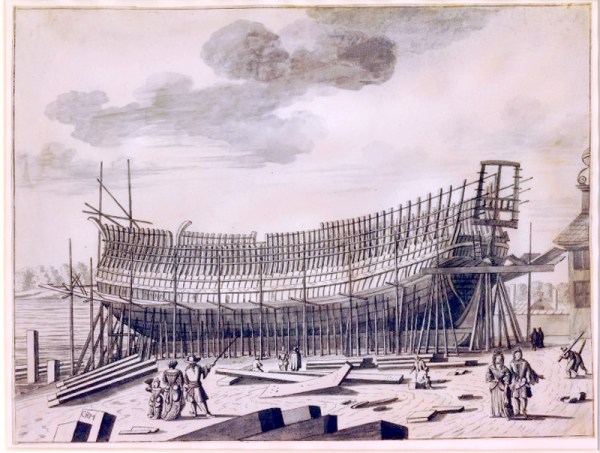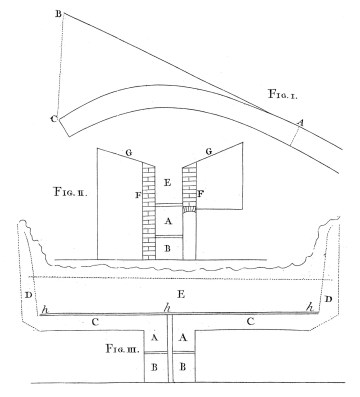
An Account of the Manner of bending Planks in His Majeſty’s Yards at Deptford, &c. by a Sand-heat, invented by Captain Cumberland.
By Robert Cay, Eſq;
The place, where the Planks lie to be ſoftened in the Stove, is between two Brick-Walls; of ſuch a length, height, and diſtance from each other, as ſuffice to admit the largeſt, or to hold a good number of the ſmaller Sort: the bottom is of thick Iron Plates, ſupported by ſtrong Bars; under the middle of which, are two Fire-places, whoſe Flews carry the Flame towards the Ends.
The Planks are laid in Sand; the loweſt about ſix or eight Inches above the Iron-Plates, they are well cover’d with the Sand, and Boards laid over all, to keep in the Heat. The Sand is moiſtened with warm Water, (for which purpoſe they have a Cauldron adjoyning to the Stove) and if the Timber be large, and intended to be very much bent, ſo that it muſt lie long in the Stove, they water the Sand again, once in 8 or 10 Hours.
When ’tis judged to be ſoft enough, the Sand is remov’d; and the Workmen carry away their reſpective Planks, to the ſeveral Places, where they are to be us’d; and having firſt nail’d a thin Board upon the out-ſide, to preſerve the Plank from Bruiſes, they fix one part in its proper place, and bring to the others, by any power they can moſt conveniently apply.
This Work ſeems to be perform’d with wonderful Eaſe; notwithstanding ſome we ſaw were ſo knotty, that the Builders aſſur’d us, they cou’d not have brought them to that Curvature by the former Methods. Thoſe we ſaw put in between others, very exactly fitted the Spaces they had been cut for; and Workmen told us, they had made no Allowance either for ſwelling, or ſhrinking of the Wood.
This Method excells that of burning the Planks over an open Fire in ſeveral reſpects: particularly, that no part of the Wood is destroy’d, but remains of the ſame Dimenſions; at leaſt very nearly; a Plank of the breadth of l6 Inches being ſaid not to alter above 1/20 part of an Inch. The Edges of the Plank are preserv’d; and conſequently the Work muſt be much firmer, and the Caulking laſt longer.
The extraordinary ſoftneſs of the Wood, while ’tis warm, makes it eaſily bend to any Figure neceſſary in Ship-building, which it holds very well, if they have occaſion to take it off again after it is cold. whereas the Plank bent by burning, would ſtart when looſened; and could only be fixed to the Timbers by ſuch a force, as was able to overcome the Reſiſtance occaſion’d by the Spring of the Plank. It likewiſe adapts it ſelf very readily to the Surface of the Timbers, if they happen to be uneven.
They ſhew’d us the Gun Deck-Clamps in a Ship of the Second Rate; which are very large Planks, bent and twiſted in ſo peculiar a manner, that they never could by any other Method, bend them into that Form, but uſed to cut them into Shape. The whole Operation is perform’d with much leſs trouble to the Carpenters, as well as at leſs Expence; and they hope the Wood will be more durable; as tis evident, from the deep Tincture the Sand receives, that a conſiderable quantity of Sap comes out of the Oak, while its in the Stove: and a large Plank was obſerv’d by the Workmen or Officers of the Yard, to weigh ſome Pounds leſs, when it was taken out.
A Plank five Inches thick requires five or ſix Hours to make it fit for bending; and the Time requiſite for others, ſeems to be in a Duplicate Proportion to their thickneſs.

Explanation of the Figures.
Fig. 1. Repreſents a Plank, in the Buttocks of a Second Rate Ship, whoſe length from A to C. is three Feet, and thickneſs (AF) 4¼ Inches, the end C, of this Plank was bent 12 or 13 Inches from the ſtreight Line AB
Fig. 2. and 3. are Sections of the Stove.
A.A. the Fire-places.
B.B. the Aſh-holes.
C.C. the Flews under the Iron bottom.
D.D. the two Chimneys.
E. the place for the Planks and Sand.
F.F. the two Brick-walls.
G.G. two inclin’d planes, for the Men to ſtand on, &c. when they put in, or take out Planks, or water the Sand.
h.h. the bottom of the Stove, made of Iron.
i.i. the Grates to lay the Fewel on.
The Philosophical Transactions of the Royal Society of London.
Vol. 32 – Jan 1. 1722
—Jeff Burks